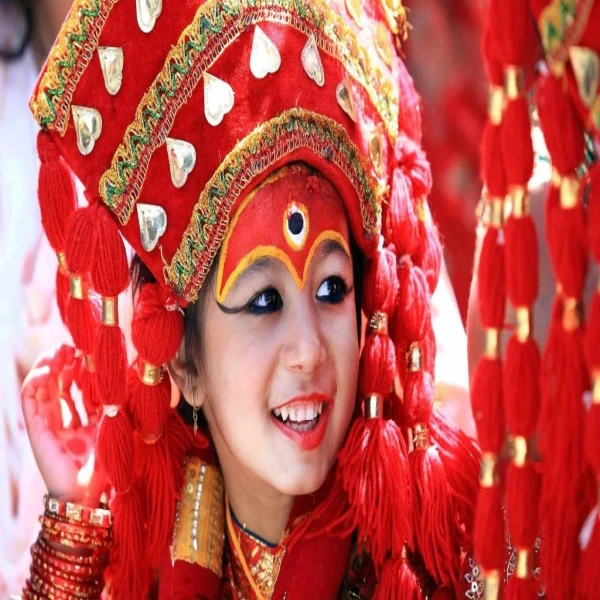How is the living goddess Kumari chosen in Nepal?
How is the living goddess Kumari chosen in Nepal? What are the other rituals girls need to follow in Nepalese culture?
Nepal is a country of many rituals, where almost every community practices some tradition, and no season is without ritual ceremonies. Our country is unique and can be titled "the Museum of Rituals," where different ancient rituals and practices still exist. The rituals are based on myths, spiritual traditions, and religion.
Who is Kumari?
In Nepal, the Kumari is a young girl considered a living goddess and worshiped by both Hindus and Buddhists. The selection process for becoming a Kumari is steeped in tradition and involves several steps.
- The Kumari must be a young girl from the Shakya caste of the Newari community, born under specific astrological signs during the day.
- Kumari must pass a series of physical tests to determine if she possesses the 32 perfections that are believed to be a sign of divinity.
- She must also pass behavioral tests, including the ability to remain unafraid during frightening situations and to demonstrate a serene and detached demeanor.
- A panel of Hindu and Buddhist priests conducts the tests and makes the final determination.
- If the girl passes all the tests, she is installed as the Kumari and begins her life as a living goddess. She is worshipped by devotees and makes public appearances on religious holidays and special occasions.
- It's worth noting that Kumari's status is not permanent, and she will eventually reach puberty and step down, at which point the selection process will begin again.
- It is practiced in the Newari community. Kumari is the pre-pubertal virgin girl. The ritual is taken as a power, pageantry, and beauty tradition. The kumari is then given a heavy ornament and the red forehead of the kumari is worshiped as the incarnation of Goddess Taleju. Kumari must be provided with all kinds of facilities, even for her schooling and education is provided, within the "Kumari Ghar" where she lives and is not allowed to go out.
General overview of the steps involved in choosing a Kumari
- The search for the Kumari begins when the current Kumari reaches puberty and is no longer considered pure.
- The prospective Kumari must be a young girl from the Shakya caste of the Newari community, born during the day and under specific astrological signs.
- The girl is then subjected to a series of physical tests, including examining her eyes, skin, and hair, to determine if she possesses the 32 perfections that are believed to be a sign of divinity.
- The girl must also pass a series of behavioral tests, including the ability to remain unafraid during frightening situations and to demonstrate a serene and detached demeanor.
- If the girl passes all the tests, she is installed as the Kumari and begins her life as a living goddess. She is worshipped by devotees and makes public appearances on religious holidays and special occasions.
- It's worth noting that Kumari's status is not permanent, and she will eventually reach puberty and step down, at which point the selection process will begin again.
Some other rituals that girls go along with in Nepal
There are many different rituals for girls in the Newari culture:
- "Ihi" is the ceremony where the girl gets married with a fruit named Bael (wood apple), a tradition devoted to lord Vishnu. The girlsget ready in the red bridal dresses with beautiful ornaments.
- Another ritual is the Bahra ceremony. It is a 12-day ceremony where girls between the age of 7 to 13 participate. In this ceromony young girls are married to the sun. The girls are dressed as brides and are wrapped and made ready for marriage. This ceremony is also known as the "second marriage" of the girls, as the first is the Ihi. This ceremony is celebrated by the girl after her first menstruation. These rituals indicated the girl's maturation stages. These ceremonies are held for a limited time and are considered must-do activities by the Newar community. Along with the feast and celebration, it also brings the concepts of discrimination regarding caste and untouchability.
- "Deuki Pratha" in the far western region of Nepal creates trouble for girls in the name of culture and religion. This ritual is often practiced with a motive of offering the girls to the temple and leaving them to live and reside with the God. The girls then become Deukis either by their parents will providing them to the temple in hope of getting protection and good favor from God or by selling their daughters to wealthier couples seeking the same approval. It is a matter of pride and status for the people who practiced scarification. Perhaps the ancestors created such practices for the benefit of women. Still, such methods have now led to girls becoming prostitutes.
- Similarly, the "Chaupadi Pratha" in the mid-wstern and the western region of Nepal has punished the young girls even for the natural cause of mensuration process. The women are forced to live in the mud hut (mud house), entirely separate from the house or hundreds of yards away. When a woman needs more nutrition and care, she is provided with the worst conditions between dirty cowsheds, malnutrition, and infections. Even the women who have just given birth are categorized as untouchable.
- The "Polyandry Marriage System" in the northwest part of Nepal has even sacrificed the human rights of girls as they areforced to have multiple husbands.
- The "Jhuma Pratha" in eastern Nepal is similar to "Deuki Pratha." It is common among the Sherpas . Its practiced by offering the second daughter to the monastery as female nuns (ANI) in exchange for serving God. She remains unmarried her entire life, and if she ever gives birth to a child, the child born from her would become the Lama of the monastery she serves at. The child offered to the monastery is deprived of parental love and forced to kill her desires and dreams. The mentality of the people is that sons are superior to daughters, which encourages such rituals. Yes, our rituals are indeed the living memories of our ancestors, and they are our identity.
Conclusion
Good rituals are blessings, but the rituals that cause problems for girls and humanity are nothing more than a burden. We must practice, protect, and preserve the good that supports humanity and reject those that reject society.







